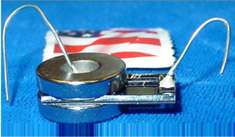Tiny wireless Geiger counter detects radiation

A postage stamp-sized Geiger counter placed unobtrusively in stadiums, subways, malls and other large public spaces could detect radiation and determine whether it's a harmful source, like a dirty bomb.
The hope is the small device will eventually replace the bulky, individually operated units now in use, says a University of Michigan researcher who helped develop the Geiger counter.
Yogesh Gianchandani, professor of electrical engineering and computer science and also mechanical engineering, said the tiny Geiger counter is wireless, so that many can be used in a network to blanket large spaces and communicate information to a central monitoring source.
The project unfolded over several years, said Gianchandani, and many students and collaborators who have come and gone through his lab contributed significantly to the project.
Geiger counters rely on electrical discharges that happen when gas sealed inside the device comes in contact with radiation, which creates electrons and ions that break down the gas to produce a signal that the Geiger can read. The first major developments in the U-M project happened several years ago, when then-post-doctoral researcher Chester Wilson and Gianchandani figured out how to shrink the device from the size of a breadbox to a wristwatch.
They scaled down a traditional Geiger counter, enclosing the gas in silicon and glass microstructure. Wilson also led the way in developing a way to differentiate between harmful and non-harmful sources or radiation. One problem with radiation detection, said Gianchandani, is that there really isn't an easy way to pinpoint the chemical nature of the source of radiation.
"There are things that are mildly radioactive but are completely harmless," he said. Other materials are more harmful, for example Strontium 90, which is a byproduct of nuclear waste and is stored by the body in our bones.
Then-undergrad Christine Eun assumed the project in spring 2004 after Wilson left for an assistant professorship at Louisiana Tech University. Working with Gianchandani and Ranjit Gharpurey, then-assistant professor of electrical engineering and computer science, Eun discovered that because of the structure of Wilson's micro-Geiger counter, the discharges produced radio frequency spectra that could be picked up by her ordinary clock radio.
Eun stood in her office and listened: What sounded like bacon sizzling on the radio was actually the radio frequency signal generated by the electrical discharges of the micro Geiger.
In the latest work, Eun incorporated permanent magnets onto the device, and that increased the signal strength so it's well within the range for broadband wireless communication. This wireless capability means that the micro-Geiger counter can be networked over large spaces, and can communicate back to a central monitoring station. Those results were scheduled to be presented today at the Solid State Sensors, Actuators and Microsystems Workshop in Hilton Head, S.C.
"In the longer term, we hope to use it in a variety of applications," Eun said.
Eventually, the hope is to build these networks in large public places.
"We could cover a wide area with these small devices so you don't have to have one person going around scanning everything," she said.
Source: University of Michigan





















